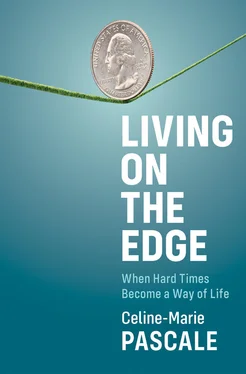Framework 1: Work – Unemployment and Underemployment
When we are told good news about unemployment, it can be tempting to personalize poverty: If the economy is good, then there must be something wrong with the people who are struggling to make it. In 2018, unemployment in the US stood at 3.9%. 5Fifty years ago, this figure would have meant that people were employed in jobs that paid well and that fewer families struggled. In the twenty-first century, however, the unemployment rate means something quite different. The US economy now has both low unemployment and high poverty. Nearly half of US workers are underemployed – even though they have jobs, they struggle to make a living. 6Despite full-time work, indeed despite working two or three jobs, many people have trouble making ends meet each month. Since there is more to the unemployment rate than meets the eye, it’s worth taking a moment to wade into the numbers.
When the media and politicians report on unemployment they use what is known as the U-3 rate, developed by the Bureau of Labor Statistics (BLS). The BLS surveys 60,000 randomly selected households regarding the employment status of each person in the household who is sixteen or older and gathers information about the number of people drawing unemployment benefits. To be counted in the unemployment rate, not only do you have to be unemployed, you must have actively looked for work in the past four weeks . The survey does not count people who have accepted part-time work but are looking for full-time work, people who are despondent after losing a job and not looking for another one, or people who looked for work and then gave up.
The U-3 rate is used so often that many folks don’t know there is another government measure of unemployment known as the U-6 rate. The U-6 rate is based on surveys that identify workers who have been looking for work in the past year as well as those who are considered to be underemployed because they have a part-time job but would like to work full-time. Economists and many other experts consider the U-6 rate to be a more reliable measure of unemployment. It captures a lot of what the U-3 rate misses. As a result, in December 2018, while the media was using the U-3 rate to tout a record low unemployment figure of 3.9%, the U-6 rate was 7.6%. 7
A devil’s advocate might argue that if we always use the U-3 rate then we’re comparing apples to apples every year and so downward trends are always good news. The reality is more complicated. Factory layoffs in one state might be balanced by an increase of service jobs in another state, which will make the unemployment rate look stable even as the workers in both states suffer. Job growth in poorly paid sectors of the economy and a general lack of wage growth in other sectors can devastate people’s daily lives without disturbing the unemployment numbers. Finally, all unemployment rates go down when unemployed people stop looking for work. Increased hopelessness can produce “good” economic figures. The focus on unemployment provides an overly simplistic picture that completely misses important issues, while the government’s narrow definition of underemployment distorts the reality of the economic landscape.
Unlike government officials, many sociologists and economists would call you underemployed if you work full-time but live at or below the poverty line; if you have multiple part-time jobs; or, if you need to work a full-time job and perhaps one or two other part-time jobs to make ends meet. For the most part, underemployed people have taken jobs that don’t utilize their skills, experience, or training, because they are desperate to just cover their bills. They might work as many as sixty hours per week at part-time jobs and completely miss opportunities for health insurance, sick time, vacation time, and retirement plans. In the twenty-first-century economy, a growing segment of the US population has been relegated to work that does not provide a basic level of self-sufficiency. They are suffering from structural changes in the economy that have created chronic underemployment .
Low-wage work is the primary driver of underemployment and economic struggle. For example, the largest employer in the United States today is Walmart: 2.3 million people work for Walmart. Although it primarily hires part-time workers, even its full-time workers need (and qualify for) federal assistance provided by the Supplemental Nutrition Assistance Program (SNAP). 8Full-time Walmart employees earn between $20,738 and $21,632 – less than the $25,149 the Walton family earns in dividends in a single minute . 9The Walton family gets $4 million richer every hour. By 2018 they had topped the list of the world’s richest families with $191 billion. 10
The fact that Walmart pays its full-time workers an annual wage that places them at or below the federal poverty line is not an accident or an oversight. It is a business plan. A study by Americans for Tax Fairness found that Walmart’s low wages across the country cost taxpayers $13.5 billion in food assistance provided by SNAP in 2013 alone. 11By 2015, the business practice of underpaying workers had enabled the Walton family to amass more wealth than 42% of American families combined . 12The second and third largest employers in the nation, Amazon and Kroger are also less than worker friendly. Amazon recently increased its warehouse wage to $15 an hour but still demands unsustainable levels of productivity from workers (more on this in a moment). Meanwhile many of the workers at Kroger, the third largest employer, are paid so little they also are forced to rely on SNAP. 13Whole Foods, a subsidiary of Amazon, announced in 2018 that it would cut medical benefits for its entire part-time workforce – the annual saving produced by this was about equal to what Jeff Bezos makes in two hours. 14These are only three examples from a much longer list. But the bad news actually gets worse.
It seems like common sense that if a company pays workers so badly that they need SNAP benefits, or demands levels of worker productivity that consistently result in injury, then cities and states would shun them. Who wants to bring jobs like that to town? Apparently, a lot of highly paid government officials. In 2019, Amazon donated more than $1 million to the campaigns of city council members it judged to be compliant with its agenda. 15Thanks to deals local governments have negotiated with corporations, taxpayers not only subsidize these companies by providing food assistance to underpaid workers, we also subsidize them when local governments agree to provide them with huge tax breaks, fee waivers, and cash grants. As cities compete against each other to bring in Amazon, successful bids start at $1 billion (Atlanta) and go as high as $7 billion (Newark). 16Given the company’s explicit requests for economic enticements, you might believe that Amazon was a great employer. The question should be great for whom? Politicians point to the number of new jobs the company creates and the increased tax revenue. While Amazon recently raised its wage to $15 an hour, that increase has been offset by injuries to workers caused by a quota system that demands they scan more than 300 items per hour over the course of their ten-hour shifts. 17Conditions in Amazon warehouses have long been under scrutiny. Like all business, it does promise to generate valuable tax revenue, but that promise is undercut by billions of dollars in tax breaks. Maryland’s Montgomery County is reported to have offered Amazon $6.5 billion in tax incentives. 18This way of doing business is shocking and deserves a book-length analysis on its own. For now, I can only say that this kind of economy makes sense only to the super-rich who benefit from it. To bring these businesses to town, elected officials have to sell out workers – often the very people who voted for them.
Читать дальше












